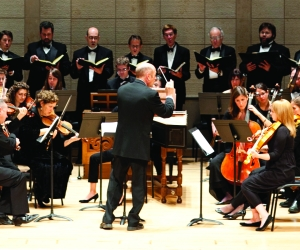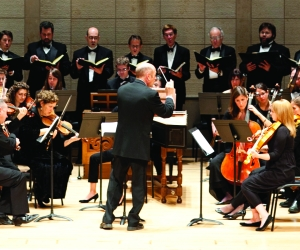
When people ask about my religious views, one of my stock answers is that I’m a firm believer — from the first note of a Bach Passion to its last. Such is the force of one of the 18th century’s greatest composers, who wrote for a public that favored intensely personal, deeply emotional religious experiences. When I heard the American Bach Soloists perform the St. John Passion in Belvedere Friday, the unashamed earnestness of their presentation was a powerful example of how persuasive and even seductive this music can be when under the care of great performers.
Most persuasive preachers understand something about drama and pacing. And there are few parts of the Bible more inherently dramatic than the story of Jesus’ arrest, trial, crucifixion, and death. These are the elements that make up the librettos of Passion settings, which had been performed in a modern oratorio style (that is, with recitatives and arias sung by biblical personae, unnamed characters, and dramatic choruses) in Leipzig before Bach became Cantor there, since Georg Philipp Telemann instituted the practice on Good Friday, 1717. Like these earlier Passion settings, Bach’s fell into two parts, because they had to accommodate sermons in their midst. (Today, we just have intermissions.) Bach produced five such works, according to his son, though only two have come down to posterity.
However, you might say that there are more than two extant Bach Passions if you take into account the fact that Bach, an inveterate reviser, produced drastically different versions of the St. John Passion each time he revived it, changing its opening and closing choruses, extending and truncating arias and recitatives, and tinkering with its libretto. The situation with this work’s scores is so complex that it’s hardly possible to say that we really know exactly what the contents of these various versions were.
This was historically informed performance at its best — not attempting some impossible ideal of transporting us back in time to hear it “like it was.”
So ABS Artistic Director Jeffrey Thomas didn’t try to present the 1724 version or the 1725 version or the 1749 version; instead, he used the 1725 version as his basic text, but incorporated some of Bach’s later changes, as he expressed in a performance note: “Since it is not possible to reconstruct an exact performance [of any of Bach’s various versions of the St. John Passion], we instead try to combine scholarship with our understanding of style to arrive at the guidelines for our performances.” In other words, this was historically informed performance at its best — not attempting some impossible ideal of transporting us back in time to hear it “like it was,” but instead crafting a fresh and compelling performance of something new, relying on that very 18th-century notion of bon goût as the determining factor. (And Thomas’ goût is definitely bon.)
The St. John Passion does have some problems beyond its thorny textual history. One of the work’s most dangerous pitfalls is its penchant for tedium. One singer acts as narrator throughout the entire work, the so-called Evangelist. Since his role is to provide framework, it stands to reason that he will sing lots and lots of recitative. In the wrong hands, this role can become dull, either an embarrassed rattling off of unemotional narration or an overly aggressive, pulpit-thumping presentational style. And then there’s the chorus, which might be diagnosed with a severe case of schizophrenia; it’s forced to switch back and forth between various roles — as a collective voice for the devout Lutherans of Bach’s audience, as Roman soldiers divvying up Jesus’ clothing as he hangs dying on the cross, and as the rabble of bloodthirsty Jews. (Yes, the work is blatantly, hair-raisingly, unambiguously anti-Semitic, another of its inherent problems.)
Obstacles Winningly Overcome
ABS masterfully surmounted these difficulties. Thomas showed dramatic sensitivity to pacing and timing. The first half moved at a slow, contemplative speed, particularly in the chorales, saving energy for an aggressive change of pace in the second half, with the chorus’ onslaught of contrapuntal calls for crucifixion and canonic expostulations of Jewish law. Thomas employed other effective and surprising interpretive touches for the choruses that kept things interesting. Most of those rousing imitative choruses were presented as rabid expressions of aggression, but Thomas led “Lasset uns den nicht zerteilen” (Let's not tear it), in which the Roman soldiers decide to cast lots for Jesus’ garments, in a hushed manner that made Bach’s intricate counterpoint crystalline, and was spine-tinglingly creepy. Never have I heard this chorus so presented, or so effective.
Aaron Sheehan and William Sharp are singers who understand the drama of persuasion.
Aaron Sheehan sang the part of the Evangelist, and his performance was quite simply astounding. He sang with clarity, both of diction (I understood every word he sang) and of conviction. His presentation was slow, measured, and authoritative, building up to those climactic moments when even the Evangelist can’t subdue his emotions, such as his musical outburst at Peter’s weeping following his denial of Jesus, or the programmatic depiction of the earthquake and grave-opening following Jesus’ death. William Sharp’s Jesus was similarly eloquent, stoic for most of the performance, but suddenly erupting in an overwhelming outpouring of emotion in his one aria, “Mein teuer Heiland, laß dich fragen” (My beloved Saviour, let me ask you). These are singers who understand the drama of persuasion.
Lutherans in the 18th century demanded not only persuasion but also seduction in their religion. Leipzig was the seat of German Pietism, with its emphasis on personal religion and a tendency to obsess about the agony that precedes salvation. Pietistic poetry of the period (and the libretto of the St. John Passion definitely fits this bill) is filled with bodily imagery, long meditations on pain and pleasure, and distinctively erotic undertones.
All that pietistic poetry is more than a curious product of a particular cultural moment; it’s a fervent outpouring of emotion, an unabashed expression of love.
Countertenor Brennan Hall most effectively conveyed this side of the Passion, with his silky vocal production and a suave presentation. His performance of “Von den Stricken meiner Sünden” was richly expressive, and he offered the slowest “Es ist vollbracht” that I’ve ever heard live, lending the aria a deep seriousness that for me was the highlight of the entire evening. It was a reminder of why the St. John Passion is such a great work. Yes, its musical structure is ingenious, but the work’s effectiveness stems from its deep attachment to its subject matter. All that pietistic poetry is more than a curious product of a particular cultural moment; it’s a fervent outpouring of emotion, an unabashed expression of love.
This warm enthusiasm infused ABS’ opening night of this concert set. Repeat performances throughout this weekend should not be missed by listeners willing to be persuaded and seduced, if only for a couple of hours, by the greatest musical evangelist of the 18th century.

